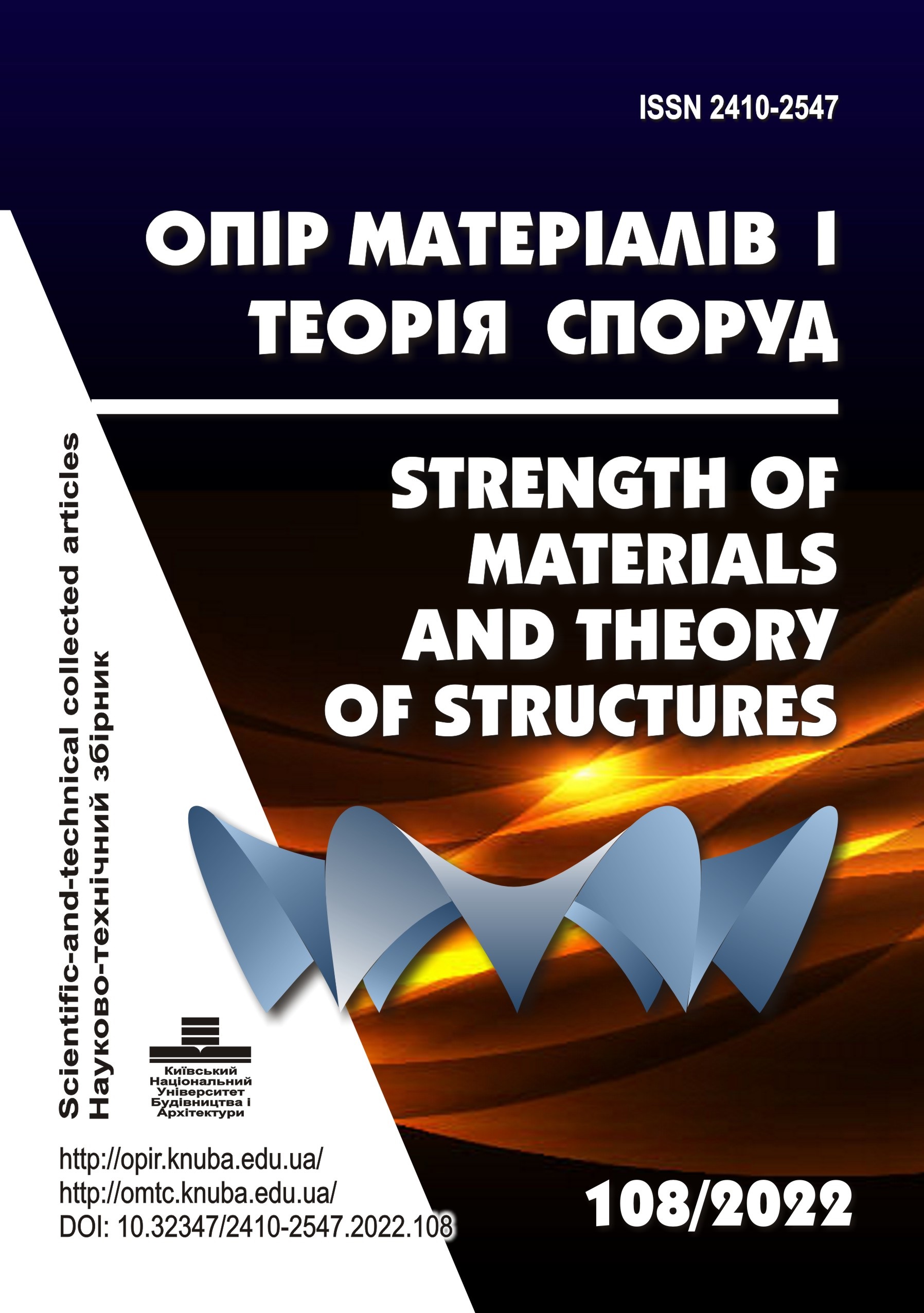Optimal topology of retaining wall
DOI:
https://doi.org/10.32347/2410-2547.2022.108.369-376Keywords:
retaining wall, topology, topology, optimization, discretization, filter, evolutionary structural optimization, SIMP methodAbstract
This paper intends to present an approach to the problem of the optimal cross-section topology of a retaining wall. We use the Solid Isotropic Material with Penalization (SIMP) method to solve this problem. An isotropic solid is divided into n quadrilateral finite elements, and each such element e is associated with a design variable xe which might be regarded as a material density. The notion of a virtual Young's modulus is introduced, and for each element it can be approximated as follows: , where p is a penalty, which is usually equal to 3; Emin is a small value of the modulus, which we use in order to avoid the singularity of a stiffness matrix; E0 is the Young's modulus of the material. Thus when the condition 0 ≤ xep ≤ 1 is satisfied Ee varies between a certain minimum value Emin and the usual Young's modulus E0. We regard a retaining wall with a solid cross-section in the form of a rectangle with a height to base ratio of 3:1 to demonstrate the proposed approach. Along its entire height the wall is under the pressure of soil, which varies linearly from 0 to 1. In general, this corresponds to hydrostatic pressure. From the standpoint of the theory of elasticity such a problem can be considered as planar. The problem of the optimal topology shrinks to the mathematical programming problem in the form of under certain conditions (here F is a vector of external forces, u(x) is a vector of displacements, x is a vector of densities). The objective function can be interpreted as the work done by external forces to deform the system, thus we tend to find the stiffest body of a certain volume. To solve mathematical programming problem we use Python programming language, and Numpy and Scipy packages. To eliminate the “checkerboard problem” (alternation of black and white cells) we apply a Gaussian filter from the Skimage package. The parameters of the obtained model are described in ANSYS Parametric Design Language and exported to Ansys Mechanical for further analysis. It is determined that the maximum von Mises stress in the structure with the optimal topology and the prescribed volume fraction of 60% does not exceed this value in the retaining wall with a base rectangular cross section.
References
Egorov E.A., Kucherenko A.E. Nonlinear topology optimization of space truss-like structures // Strength of Materials and Theory of Structures: Scientific-and-technical collected articles – Kyiv: KNUBA, 2018. – Issue 100. – P. 105-114.
Bezuhov N.I. Podpornye stenki. Moscow: Gos. izd-vo, 1931, 95 pp.
Pan Y., Zhang Y., Zhang D. 3D printing in construction: state of the art and applications. – Int J Adv Manuf Technol. – 2021. – Vol. 115. – P. 1329-1348.
Huang X., Xie Y. A further review of ESO type methods for topology optimization.– Struct Multidisc Optim. – 2010. – Vol. 41. – P. 671–683.
Xie Y., Steven G. Evolutionary structural optimization for dynamic problems. – Comput Struct. – 1996. – Vol. 58. – No. 6. – P. 1067–1073.
Xia L., Xia Q., Huang X. Bi-directional Evolutionary Structural Optimization on Advanced Structures and Materials: A Comprehensive Review. – Arch Computat Methods Eng. – 2018 – Vol. 25. – P. 437–478.
Bendsøe M.P. Optimal shape design as a material distribution problem. – Structural Optimization. – 1989. – Vol. 1. – No. 4. – P. 193–202.
Andreassen E., Clausen A., Schevenels M. Efficient topology optimization in MATLAB using 88 lines of code. – Struct Multidisc Optim. – 2011. – Vol. 43. – P. 1–16.
Kats A.M. Teoriya uprugosti. Saint Petersburg: Izdatelstvo “Lan”, 2002, 208 pp.
Harris C.R., Millman K.J., van der Walt S.J. Array programming with NumPy. – Nature. – 2020. – Vol. 585. – P. 357–362.
Virtanen P., Gommers R., Oliphant T.E. SciPy 1.0: Fundamental Algorithms for Scientific Computing in Python. – Nature Methods. – 2020. – Vol. 17. – P. 261–272.
Lazarov B.S., Sigmund O. Filters in topology optimization based on Helmholtz-type differential equations. – International Journal for Numerical Methods in Engineering. – 2011. – Vol. 86. – P. 765–781.
Downloads
Published
Issue
Section
License

This work is licensed under a Creative Commons Attribution 4.0 International License.
Authors retain copyright and grant the journal right of first publication with the work simultaneously licensed under a Creative Commons Attribution License that allows others to share the work with an acknowledgement of the work's authorship and initial publication in this journal.

